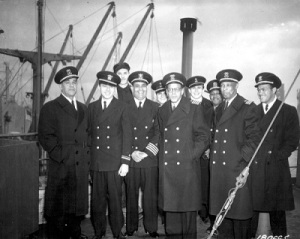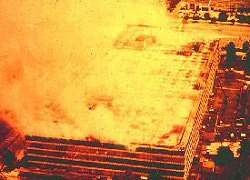NARA’s Virtual World of Military Records
In my last post, I talked about U.S. veterans’ military records that were destroyed in the Great NARA Fire of 1973. While those searching for information on vets whose records were incinerated will have a harder time of it, the good news is that the National Archives has a wealth of military records information available online.
Warning: If you’re at all interested in military history, then be prepared to spend a lot of time checking it all out. And if you only want to track down one person, you’ll likely come up with numerous leads.
While this is by no means a comprehensive list of all the resources available, here are several good places to start:
Historical Documents of Interest to Veterans. This provides a general overview of all the records the National Archives has that pertain to the military. Links from this site take you to more specific areas of research.
An Overview of Records at the National Archives Relating to Military Service, by Trevor K. Plante, which was published in the Fall 2002 issue of Prologue. It will help you understand which branch of NARA holds which records, how searching for volunteers varies from searching from enlisted men or officers, and how the branch of service will influence your search techniques.
20th Century Veterans’ Service Records, by Norman Eisenberg, published in Prologue’s Spring 2005 issue, discusses the history of the National Personnel Records Center, what military records look like, what they contain, and how the record-ordering process works.
Genealogy Research in Military Records. This offers information about what kind of details you can discover from military records. Pension applications, for example, often included supporting information such as pages from family Bibles or copies of marriage certificates.
You will not want to miss a visit to Online Veterans and Military Records, which features a vast selection of digitized military documents. Among the dozens of resources available here are:
- World War II Honor Lists of Dead and Missing, broken down by state;
- Images of U.S. Navy ships;
- Sample personnel files;
- Korean and Vietnam casualty lists by state;
- Pictures of African-American Men During World War II;
- Selected Spanish-American War Records;
- ARC Gallery: Revolutionary War.
The Veterans Service Records main page. If you are the next of kin of a veteran, you can access eVetRecs and request a veteran’s record. A separation document, which indicates a veteran’s years of service, type of discharge, and information such as birthdate and place of birth, is available for free. This applies to non-archival records. If a record is from mid-1949 or earlier, it is archival, and you don’t need to be a next of kin to have access to it. If the final discharge date of the veteran is 62 years ago today or earlier, the record is in the public domain. Find more on the difference between archival and non-archival records.
Another helpful resource is the brochure, Finding Information on Personal Participation in World War II, available as a pdf.
And if you’re looking for print resources, the National Archives Online Bookstore sells both genealogy and military history books.
The National Personnel Records Center and Archival Research Room
Fire!
On July 12, 1973, just after midnight, a fire broke out at the National Archives National Personnel Records Center at 9700 Page Avenue in Overland, Mo. When it was finally extinguished days later, the entire sixth floor was gone. Sixteen million to 18 million Official Military Personnel Files were lost as a result of the fire. None of them had been duplicated, nor had they been copied to microfilm.
So, if you are looking for information on an ancestor who served in the Army between Nov. 1, 1912, and Jan. 1, 1960, or in the Air Force between Sept. 25, 1947, and Jan. 1, 1964 (with names alphabetically after Hubbard, James E.), chances are very good that his or her military record was incinerated.
You may get lucky, though. More than 4 million records from the above branches and time periods survived in some form or another. Some are so burned as to be unreadable, while many others require treatment by the NPRC Preservation Department before they can be viewed or copied. Still, a partial record is better than none at all.
But what can you do if the record you want was totally destroyed? There are other options.
Start with Alternate Record Sources. The Reconstruction Department at NPRC (MPR) (Military Personnel Records) attempts to compile basic military service data from sources other than the official record. You can help by filling out and sending in a Questionnaire About Military Service, or, if you’re looking for medical data (for example, to trace a genetic disease or look into possible radiation exposure), a Request for Information Needed to Reconstruct Medical Data. Additionally, for the past decade the Reformatting Division staff has been microfilming pay vouchers, which provide name, service number, dates of service, and character of service.
Another source of material is NARA’s Access to Archival Databases. NARA is slowly digitizing its holdings, and the AAD has many files related to wars available online. Selected ones are currently available from the Civil War, World Wars I and II, the Korean War, Vietnam War, and even the Cold War.
If you need to find a World War II veteran’s service number (which can come in handy, especially if he/she has a common name), you can find it in the Electronic Army Serial Number Merged File, ca. 1938 – 1946.
Service numbers, which were issued between 1918 and 1974, can themselves offer research clues. In many cases the numbers (also called serial numbers) were issued serially. So, if you know that an ancestor enlisted at the same time as another individual (such as a close friend), you could look up that person’s name and find out when he enlisted. The first three digits in a service number indicate which state a veteran was in at the time of enlistment. Officers received fewer-digit numbers than regular service members did. The Wikipedia entry on service numbers gives a through breakdown on the finer points of these numbers.
By these means, you may be able to obtain basic information. But in order to flesh out the details, you may want to visit the Archival Research Room, for records 62 years and older, or the Federal Records Center Research Room, both at the new National Archives building in St. Louis. (Read more on archival vs. non-archival records.) The FRC research room is where you’d go to look at records that are less than 62 years old. It is designed primarily to help veterans or next of kin.
The ARR has microfilm of Morning Reports and Unit Rosters for World Wars I and II. (You can also order this material via mail, but fees are charged.)
Morning reports are released every morning by all military units, and they indicate who did not report for roll call on a given morning–who was in sick bay, for example, or AWOL, or killed in action, or transferred. The ARR collection covers the dates Nov. 1, 1912, to 1974 for the Army, and September 1947 to June 30, 1966, for the Air Force. Since these are organized by “unit of assignment” it helps to know exactly where and in what unit a vet was assigned.
Unit rosters list the members of a particular unit for the last day of the month in which the roster was created. The ARR only has these for the Army.
Also on microfilm are:
- Veterans Administration indices, starting with vets from WWI;
- Marine Corps service number tapes (search by name to find the number);
- Passenger lists of service members who were transported by ship and plane.
Print resources include:
- Indices to World War I rolls and rosters;
- Indices to military hospitals, Army recruiting stations;
- Guides to National Guard units;
- Guides to Mexican Border service members;
- Dictionary of American Naval Fighting Ships;
- U.S. Submarine Men Lost During World War II;
- Multivolume sets on the actions of each military branch during World Wars I and II;
- Guides to the different codes one will find on military records;
- Directory of Military Personnel and Related Records;
- How to Locate Anyone Who Is or Has Been in the Military;
- Guides to military decorations;
- List of Log Books of U.S. Navy Ships and Miscellaneous Units;
and much more.
If you can’t make it to the Archival Research Room personally, you can hire a researcher to do the work for you. The ARR keeps a list of researchers.
The Archival Research Room is located at 1 Archives Drive, St. Louis. For more information, visit Archival Research Room.

